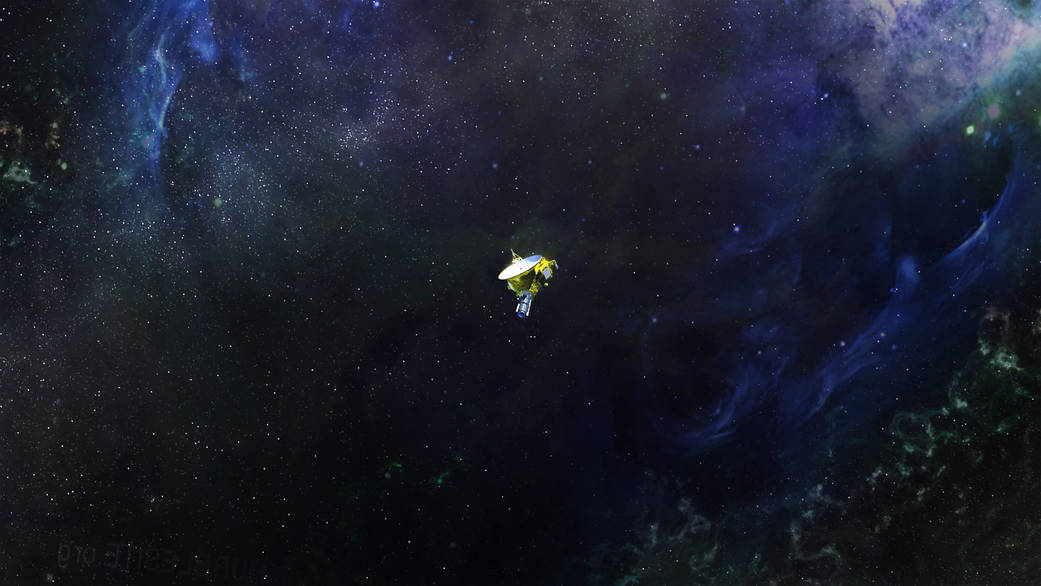The scientists who conquered Pluto
The global response to New Horizons is more than a celebration of one mission; it's the celebration of science


On the night of July 14, a small crowd gathered outside the Kossiakoff Center at the Applied Physics Laboratory campus in Laurel, Maryland. Halogen street lights cut across the darkness, outlining boom microphone operators and cameramen who looked like soldiers about to go into combat. Reporters scribbled in notepads, and a few of the faithful who absolutely couldn't wait any longer stood with mobile phones raised like Eucharistic offerings, ready to begin their furious Instagramming.
Inside the K-Center, hundreds of people lined a path to the main auditorium. They were anxious, giddy, twittering like birds and saying things that everyone already knew, but needing to say something. Most carried small American flags that had been distributed earlier in the day. Some had had a few festive drinks. It had been that kind of night.
Outside, the New Horizons team emerged from a bus to camera flashes, cheers, and applause. Alan Stern, who leads the mission, raised his fist in sheepish solidarity. When it became clear that there was movement around the bus, the crowd inside the K-Center thundered its approval as well. Minders opened doors and just under 40 members of the New Horizons team glided inside, where they were received as conquering heroes, and rightly so. They had, after all, just conquered a world.
The Week
Escape your echo chamber. Get the facts behind the news, plus analysis from multiple perspectives.

Sign up for The Week's Free Newsletters
From our morning news briefing to a weekly Good News Newsletter, get the best of The Week delivered directly to your inbox.
From our morning news briefing to a weekly Good News Newsletter, get the best of The Week delivered directly to your inbox.
It is said that a soldier doesn't salute the officer; he or she salutes the rank. When political foes of a president stand and cheer during the State of the Union address, they're not cheering a rival; they're cheering the embodiment of the United States. What was the crowd that night cheering? The team members of New Horizons, certainly. Though the press had only arrived days earlier, the New Horizons team in various forms had been working to get to Pluto since the 1980s. They formed the "Pluto Underground" in 1989, and wrote papers and lobbied NASA and the planetary science community to support a mission to the ninth planet. In a decade's time, five missions to Pluto were proposed. Five mission to Pluto were canceled. Sometimes the proposals ran into cost problems. Sometimes NASA just ran out of money.
Finally, in 2001, the New Horizons mission — what Stern called the "last chance" — got its moment. It was formally approved, designed, and built over the next five years. It launched in 2006. It took nine and a half years to reach Pluto, during which time the team planned out sequences and rehearsed every conceivable problem. Then on July 4 of this year — days before the most important moment of the mission — the spacecraft malfunctioned and entered "safe mode," threatening decades of work and hundreds of millions of dollars. It had to be fixed from Earth at a distance of just under three billion miles. The team put in 24-hour workdays, and never quite had time to catch up on sleep before the Pluto flyby. On July 14, the day of closest approach, they were exhausted and rapidly approaching incoherence.
When traveling at 31,000 miles per hour, a space rock as small as a grain of rice could destroy the spacecraft.
The New Horizons team had earned their applause, and then some. But something more, it seemed, was at work in the crowds. What of the flags? Patriotism was a recurring theme last week, but a secondary one. Undeniably, it had been an American week. Early that morning, seconds after the New Horizons spacecraft's moment of closest approach to Pluto, another packed crowd in an APL ballroom broke spontaneously into cheers of "USA! USA!" And why not? At that moment, after all, the United States had achieved a breathtaking milestone in human history: Every planet in the classical solar system had now been explored, and the first successful exploration to each had been undertaken by spacecraft built by American hands. Who during NASA's earliest years would have thought such a thing possible? Until the moon landing, the Soviet space program outfoxed NASA at every turn, beating the United States into orbit; sending the first man into space; putting a spacecraft in orbit around the sun. At the time, the most visible symbol of American space exploration was the Vanguard rocket loaded with what was to be the first American satellite. Broadcast live on television, midway during the launch countdown, the rocket rose a few inches and blew up.
A free daily email with the biggest news stories of the day – and the best features from TheWeek.com
These American voyages to the nine planets were hard fought. And so minutes after the flyby, when Stern asked the audience to "please raise your flags in appreciation," the crowd did so enthusiastically.
But this was bigger than the United States, as the enthusiastic international response suggests. It is a milestone for humanity. Fifty-eight years ago, with Sputnik I, humankind gingerly dipped its toe into an ocean of black. In 1969, we took a giant leap. On July 14, 2015, we learned how to run. And yet, for the scientists, engineers, space administrators, support staff, and family members present, "human achievement" isn't quite right either. From the outside, these are glorious firsts — well done, species! — but the men and women in the trenches of the Applied Physics Laboratory do this every day. They're the ones who machine every screw and type every line of code. They're the ones who slug it out with appropriations committees and develop new ways to harness the laws of physics. They write the papers for scientific journals, with titles like "Potential Collateral Effects in Stable Hafnium Isotopes Due to the S-Process Production of the Short-Lived Radionuclide 182Hf?". To those of us on the outside, exploring Pluto just happens. Insiders know that such things are made to happen.
"We are in lock with carrier," said Alice Bowman, who leads New Horizons' mission control. She was in the mission operations center — the Earthly half of the celestial voyage — at the Applied Physics Laboratory at Johns Hopkins University. Early that morning, when the spacecraft had made its flyby of Pluto, nobody was listening. In part, the missions team feared an "observer effect"; blasting New Horizons with signals might have interfered with its computers, creating the very error the team feared. Regardless, spying on the spacecraft would have been pointless. There's a four-and-a-half-hour delay from Pluto to Earth, and by definition, a flyby is a one-shot deal. Had the spacecraft malfunctioned (and thus reoriented itself to send a warning signal to Earth) the mission would have been lost. Instead of listening during the flyby, the mission's controllers would know the status of the spacecraft by two brief transmissions — one before, and one after. Ahead of closest approach, Bowman's team would poll the spacecraft and ask if everything was OK. After the scheduled completion of the flyby, the team would again ask if everything was OK. Before and after would suggest that during was a success as well. At 8:52 p.m. and 37 seconds, local time, NASA's Deep Space Network established contact with the spacecraft. New Horizons had survived.
Of the tremendous distance traveled by the spacecraft, the last few hours were the most dangerous. In 2011 and 2012, astronomers discovered two new moons of Pluto, bringing the total number to five. They were remarkable finds, but for the New Horizons team, troubling ones. Moons mean trouble for spacecraft — especially unexpected moons. Worlds as large as Pluto have considerable gravity, relatively speaking. When they are struck by asteroids, comets, and other large objects, impact craters might be created, but the debris kicked up falls back to the ground. That's not necessarily so with moons; without strong gravity, collisions simply blow debris into space. When planning a spacecraft's course, team members use computer software to account for such space debris. Models take into consideration orbital dynamics, and can offer reasonable predictions of where space rocks might be scattered around a planetary system. A flight path is designed to simply avoid them. But new moons mean unanticipated dangers. Worse yet for New Horizons, if two moons could be discovered so recently, there was the possibility of a sixth or more. Models can attempt to predict where other moons are likely to be, and thus where debris might be, but the possibilities are literally infinite. And it gets worse. New Horizons didn't have to slam into Moon X or Giant Rock 78 to be destroyed. When traveling at 31,000 miles per hour, a space rock as small as a grain of rice could destroy the spacecraft.
Traveling through space for nine-and-a-half years, New Horizons had to arrive within 100 seconds of the predicted time.
The spacecraft was sending engineering data to the mission operations center. That it could even do that was an encouraging sign. The string of ones and zeroes traveling across the solar system at light speed contained the status of each of the spacecraft's subsystems. At that moment, everything happened very fast, and also unbearably slowly. Each member of the mission began reporting to Bowman. Radio frequency was nominal (as expected). Autonomy was nominal. The spacecraft's memory holding the presumed data from the flyby: nominal. The guidance, navigation, and control was nominal, and thrusters were good. Propulsion was nominal. Power systems and thermal reports were nominal, "all temperatures green."
The spacecraft was in perfect condition and its memory was filled with newly acquired information.
"P.I.," said Bowman to principal investigator Stern over the radio. "MOM on Pluto-1. We have a healthy spacecraft. We've recorded data of the Pluto system and we are outbound from Pluto."
The numbers associated with the mission are inconceivable to the human mind. From a distance of three billion miles, the spacecraft had to hit a target window 200 miles in diameter. Traveling through space at speeds greater than Mach 46 for nine-and-a-half years, it had to arrive within 100 seconds of the predicted time. (It arrived within 70). New Horizons is only 9 feet long, for God's sake, and it's out there, awash in an infinite black sea — forever. Hundreds of thousands of years from now, New Horizons will presumably still be speeding along, cold but preserved. The spacecraft carries a postage stamp minted by the U.S. Postal Service in 1991. It was part of a series honoring America's exploration of the solar system. Every planet had an affiliated spacecraft (e.g., the Mercury stamp read "Mariner 10," the Venus stamp read "Mariner 2," etc.) but the stamp for Pluto — the one carried by New Horizons — read: Pluto: Not Yet Explored.
Because of the sheer, inconceivable size of space, the spacecraft will almost certainly outlive our species. Those four words will outlive the works of Shakespeare.
We know well the way astronauts think because we've studied them for so long — lionized them, rightfully, in books and movies and on television. We understand the human adventure. We understand that astronauts train hard and while in space live in pretty miserable conditions. But we also understand the glory of being an astronaut. They are humanity's ambassadors. They are exploring the final frontier. They've played golf on the moon! But what of these people — the New Horizons people, these spacecraft pilots and planetary scientists who study the outer reaches of the solar system? What can be made of them? Alice Bowman said the words, "We are outbound from Pluto." Has a more breathtaking string of words ever been uttered?
Charon, Pluto's largest moon and the counterpart to its "binary planet," exists in a tidal lock with Pluto. The two worlds forever face one another and orbit a single, invisible point between them. All that was known. But many scientists expected that Charon would appear ancient and massively cratered — a dead rock in an eternal circle dance with its host planet. New Horizons annihilated that belief. "Charon blew our socks off," said Cathy Olkin, deputy project scientist on New Horizons. Even to the untrained eye, the world is immediately fascinating. A series of troughs and cliffs extend 600 miles across the planet. Smooth regions suggest recent geological activity. High-resolution imagery reveals a canyon so deep — at least four miles down and possibly six — that you can see clean through to the other side and out into space. "It's a small world with deep canyons, troughs, cliffs, dark regions that are still slightly mysterious to us," said Olkin. "Pluto did not disappoint. I can add Charon did not disappoint, either." Unlike most north poles found in the solar system, Charon's north pole is dark and foreboding. The New Horizons team calls it Mordor.
As for Pluto, the first high-resolution photograph downloaded from the spacecraft is of an area 150 miles across. The image is so closely resolved that if APL's campus had been built on Pluto, you would have been able to spot it. The image contained a mountain range with peaks as tall as 11,000 feet. John Spencer says they "stand up respectably again the Rocky Mountains here on Earth." (Spencer is the deputy leader of geology and geophysics for the New Horizons team.)
But here's where it gets interesting. The surface of Pluto is covered in nitrogen ice, methane ice, and carbon monoxide ice. "You can't make mountains out of that stuff," he said. "It's just too soft; it doesn't have the strength to make mountains." At Pluto's temperatures, there is one thing that can hold up such a mountain: a bed of water ice. The volatile ices — nitrogen, methane, and such — are just a frosting on the surface.
The image was startling for another detail, or rather, the absence of a detail: It lacked even a single impact crater. That makes it a "young" surface in geologic terms, and it is now thought to be less than 100 million years old. But Pluto is billions of years old, and it is continually bombarded by objects in the Kuiper Belt. If craters cannot be found, then something is going on to smooth things out. "It might be active right now," said Spencer.
"This is the first time we've seen an icy world that isn't orbiting a giant planet," he said. "All the other icy worlds that we've visited have been moons of giant planets. And we see strange geological features on many of these moons and we usually attribute this to tidal heating, deformation of these worlds by the gravity of that giant planet and interactions with other moons. That can't happen on Pluto. There is no giant body that can be deforming Pluto on an ongoing, regular basis to heat the interior; Charon is just too small to do that. So this is telling us that you do not need tidal heating to power ongoing recent geological activity on icy worlds. That's a really important discovery that we just made this morning."
That remark, to an auditorium of scientists and space enthusiasts, elicited 28 seconds of applause, along with murmurs and bewildered, nervous laughter. It was back to the drawing board for them! Hypotheses and papers in progress will have to be thrown out. Textbooks will need to be rewritten. Someone's life's work has been proven incorrect, and someone's pet theory likely elevated. And here they were, everyone, cheering — cheering! — with a level of enthusiasm otherwise seen at monster truck rallies.
For what were they cheering? For whom? For the spacecraft? For the New Horizons team? For Pluto's very fine terrain? Each in part, but just as the crowd at APL cheered the moment of New Horizons' closest approach to Pluto, and just as hundreds welcomed the New Horizons team like rock stars after the spacecraft phoned home successfully, the tears and cheers and handshakes and hugs were for something more, something bigger. It was applause not for species or nationality, but for the sake of intelligence and discovery — that it's still done by people who toil, one paper at a time, to prove the need for missions that take decades to see through to completion. At APL last week, a tiny piece was presented of a massive jigsaw puzzle that will never be solved, and the scientists and the crowds and the auditorium and the whole wide world were applauding that piece. That's who planetary scientists are. That's what they do.
"These are pictures that have been a long time in the making," said Ralph McNutt, co-investigator on the science team, and a founding member of the Pluto Underground. "It's no understatement to say we're all very, very excited on the human scale, and oh my God there's some science to do as well." Tomorrow they'll search for cryo-volcanism on Pluto. Today, they celebrate the branch of human knowledge that calls for the search for ice volcanoes three billion miles away: the discipline of science.
David W. Brown is coauthor of Deep State (John Wiley & Sons, 2013) and The Command (Wiley, 2012). He is a regular contributor to TheWeek.com, Vox, The Atlantic, and mental_floss. He can be found online here.
-
 ‘City leaders must recognize its residents as part of its lifeblood’
‘City leaders must recognize its residents as part of its lifeblood’Instant Opinion Opinion, comment and editorials of the day
-
 10 upcoming albums to stream during the winter chill
10 upcoming albums to stream during the winter chillThe Week Recommends As the calendar turns to 2026, check out some new music from your favorite artists
-
 Kristi Noem might not be long for Trumpland
Kristi Noem might not be long for TrumplandIN THE SPOTLIGHT The Homeland Security secretary has been one of the most visible and vocal architects of Trump’s anti-immigration efforts, even as her own star risks fading
